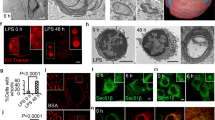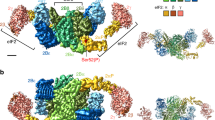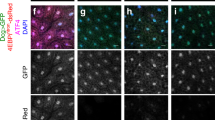Abstract
Under conditions of endoplasmic reticulum (ER) stress, mammalian cells induce both translational repression and the unfolded protein response that transcriptionally activates genes encoding ER-resident molecular chaperones. To date, the only known pathway for translational repression in response to ER stress has been the phosphorylation of eIF-2α by the double-stranded RNA-activated protein kinase (PKR) or the transmembrane PKR-like ER kinase (PERK). Here we report another pathway in which the ER transmembrane kinase/ribonuclease IRE1β induces translational repression through 28S ribosomal RNA cleavage in response to ER stress. The evidence suggests that both pathways are important for efficient translational repression during the ER stress response.
This is a preview of subscription content, access via your institution
Access options
Subscribe to this journal
Receive 12 print issues and online access
$209.00 per year
only $17.42 per issue
Buy this article
- Purchase on Springer Link
- Instant access to full article PDF
Prices may be subject to local taxes which are calculated during checkout






Similar content being viewed by others
References
Gething, M.-J. & Sambrook, J. Protein folding in the cell. Nature 355, 33–45 (1992).
Kaufman, R. J. Stress signaling from the lumen of the endoplasmic reticulum: coordination of gene transcriptional and translational controls. Genes Dev. 13, 1211–1233 (1999).
Kozutsumi, Y., Segal, M., Normington, K., Gething, M.-J. & Sambrook, J. The presence of malfolded proteins in the endoplasmic reticulum signals the induction of glucose-regulated proteins. Nature 332, 462–464 (1988).
Brostrom, C. O. & Brostrom, M. A. Calcium-dependent regulation of protein synthesis in intact mammalian cells. Annu. Rev. Physiol. 52, 577–590 (1990).
Cox, J. S., Shamu, C. E. & Walter, P. Transcriptional induction of genes encoding endoplasmic reticulum resident proteins requires a transmembrane protein kinase. Cell. 73, 1197–1206 (1993).
Mori, K., Ma, W., Gething, M.-J. & Sambrook, J. A transmembrane protein with a cdc2+/CDC28-related kinase activity is required for signaling from the ER to the nucleus. Cell. 74, 743–756 (1993).
Bork, P. & Sander, C. A hybrid protein kinase-RNase in an interferon-induced pathway? FEBS Lett. 334, 149–152 (1993).
Chapman, R., Sidrauski, C. & Walter, P. Intracellular signaling from the endoplasmic reticulum to the nucleus. Annu. Rev. Cell Dev. Biol. 14, 459–485 (1998).
Mori, K., Kawahara, T., Yoshida, H., Yanagi, H. & Yura, T. Signaling from endoplasmic reticulum to nucleus: transcription factor with a basic-leucine zipper motif is required for the unfolded protein-response pathway. Genes Cells 1, 803–817 (1996).
Kohno, K., Normington, K., Sambrook, J., Gething, M.-J. & Mori, K. The promoter region of the yeast KAR2 (BiP) gene contains a regulatory domain that responds to the presence of unfolded proteins in the endoplasmic reticulum. Mol. Cell. Biol. 13, 877–890 (1993).
Mori, K. et al. A 22 bp cis-acting element is necessary and sufficient for the induction of the yeast KAR2 (BiP) gene by unfolded proteins. EMBO J. 11, 2583–2593 (1992).
Tirasophon, W., Welihinda, A. A. & Kaufman, R. J. A stress response pathway from the endoplasmic reticulum to the nucleus requires a novel bifunctional protein kinase / endoribonuclease (Ire1p) in mammalian cells. Genes Dev. 12, 1812–1824 (1998).
Wang, X.-Z. et al. Cloning of mammalian Ire1 reveals diversity in the ER stress response. EMBO J. 17, 5708–5717 (1998).
Prostko, C. R., Brostrom, M. A., Malara, E. M. & Brostrom, C. O. Phosphorylation of eukaryotic initiation factor (eIF) 2α and inhibition of eIF-2B in GH3 pituitary cells by perturbants of early protein processing that induce GRP78. J. Biol. Chem. 267, 16751–16754 (1992).
Clemens, M. J. Regulation of eukaryotic protein synthesis by protein kinases that phosphorylate initiation factor eIF-2. Mol. Biol. Rep. 19, 201–210 (1994).
Chen, J. J. & London, I. M. Regulation of protein synthesis by heme-regulated eIF-2 alpha kinase. Trends Biochem. Sci. 20, 105–108 (1995).
Grosfeld, H. & Ochoa, S. Purification and properties of the double-stranded RNA-activated eukaryotic initiation factor 2 kinase from rabbit reticulocytes. Proc. Natl Acad. Sci. USA. 77, 6526–6530 (1980).
Shi, Y. et al. Identification and characterization of pancreatic eukaryotic initiation factor 2 alpha subunit kinase, PEK, involved in translational control. Mol. Cel. Biol. 18, 7499–7509 (1998).
Harding, H. P., Zhang, Y. & Ron, D. Protein translation and folding are coupled by an endoplasmic-reticulum-resident kinase. Nature. 397, 271–274 (1999).
Berlanga, J. J., Santoyo, J. & De Haro, C. Charaterization of a mammalian homolog of the GCN2 eukaryotic initiation factor 2α kinase. Eur. J. Biochem. 265, 754–762 (1999).
Sood, R., Porter, A. C., Olsen, D., Cavener, D. R. & Wek, R. C. A mammalian homologue of GCN2 protein kinase important for translational control by phosphorylation of eukaryotic initiation factor-2α. Genetics 154, 787–801 (2000).
Prostko, C. R., Dholakia, J. N., Brostrom, M. A. & Brostrom, C. O. Activation of the double-stranded RNA-regulated protein kinase by depletion of endoplasmic reticular calcium stores. J. Biol. Chem. 270, 6211–6215 (1995).
Srivastava, S. P., Davies, M. V. & Kaufman, R. J. Calcium depletion from the endoplasmic reticulum activates the double-stranded RNA-dependent protein kinase (PKR) to inhibit protein synthesis. J. Biol. Chem. 270, 16619–16624 (1995).
Takatsuki, A., Kohno, K. & Tamura, G. Inhibition of biosynthesis of polyisoprenol sugars in chick embryo microsomes by tunicamycin. Agric. Biol. Chem. 39, 2089–2091 (1975).
Shamu, C. E. & Walter, P. Oligomerization and phosphorylation of the Ire1p kinase during intracellular signaling from the endoplasmic reticulum to the nucleus. EMBO J. 15, 3028–3039 (1996).
Welihinda, A. A. & Kaufman, R. J. The unfolded protein response pathway in Saccharomyces cerevisiae. J. Biol. Chem. 271, 18181–18187 (1996).
Brimacombe, R. The structure of ribosomal RNA: a three-dimensional jigsaw puzzle. Eur. J. Biochem. 230, 365–383 (1995).
Dube, P et al. Correlation of the expansion segments in mammalian rRNA with the fine structure of the 80S ribosome. J. Mol. Biol. 279, 403–421 (1998).
Iordanov, M. S. et al. Activation of p38 mitogen-activated protein kinase and c-Jun NH2-terminal kinase by double-stranded RNA and encephalomyocarditis virus: involvement of RNase L, protein kinase R, and alternative pathways. Mol. Cell. Biol. 20, 617–627 (2000).
Harding, H. P., Zhang, Y., Bertolotti, A., Zeng, H. & Ron, D. Perk is essential for translational regulation and cell survival during the unfolded protein response. Mol. Cell. 5, 897–904 (2000).
Bertolotti, A., Zhang, Y., Hendershot, L. M., Harding, H. P. & Ron, D. Dynamic interaction of BiP and ER stress transducers in the unfolded-protein response. Nature Cell Biol. 2, 326–332 (2000).
Korth, M. J. & Katze, M. G. Evading the interferon response: hepatitis C virus and the interferon-induced protein kinase, PKR. Curr. Top. Microbiol. Immunol. 242, 197–224 (2000).
Wreschner, D. H., James, T. C., Silverman, R. H. & Kerr, I. M. Ribosomal RNA cleavage, nuclease activation and 2-5A (ppp(A2′p)nA) in interferon-treated cells. Nucleic Acids Res. 9, 1571–1581 (1981).
Silverman, R. H., Cayley, P. J., Knight, M., Gilbert, C. S. & Kerr, I. M. Control of the ppp(A2′p)nA system in HeLa cells. Eur. J. Biochem. 124, 131–138 (1982).
Urano, F. et al. Coupling of stress in the ER to activation of JNK protein kinases by transmembrane protein kinase IRE1. Science 287, 664–666 (2000).
Niwa, H., Yamamura, K. & Miyazaki, J. Efficient selection for high-expression transfectants with a novel eukaryotic vector. Gene 108, 193–199 (1991).
Acknowledgements
We thank R. Kaufman for the hIRE1α and hIRE1α K599A cDNAs; C. Yamamoto for constructing the His-tagged hIRE1β; L. Hendershot and members of the Kohno laboratory for discussion; K. Maekawa, M. Yamao and E. Muro for technical assistance; and I. Farcasanu for critically reading this manuscript. This work was supported by a Grant-in-Aid for Scientific Research on Priority Areas (to K.K.) from the Ministry of Education, Science, Sports and Culture of Japan, and supported in part by the Sapporo Bioscience Foundation.
Author information
Authors and Affiliations
Corresponding author
Supplementary information
Table 1 Percent of cells entering the cell cycle
Table 2 Discontinuously treating cells with growth factors drives several different cell types into S phase (PDF 13 kb)
Rights and permissions
About this article
Cite this article
Iwawaki, T., Hosoda, A., Okuda, T. et al. Translational control by the ER transmembrane kinase/ribonuclease IRE1 under ER stress. Nat Cell Biol 3, 158–164 (2001). https://doi.org/10.1038/35055065
Received:
Revised:
Accepted:
Published:
Issue Date:
DOI: https://doi.org/10.1038/35055065
This article is cited by
-
RNA disruption is a widespread phenomenon associated with stress-induced cell death in tumour cells
Scientific Reports (2023)
-
The IRE1β-mediated unfolded protein response is repressed by the chaperone AGR2 in mucin producing cells
The EMBO Journal (2023)
-
Transcriptional landscape of mitochondrial electron transport chain inhibition in renal cells
Cell Biology and Toxicology (2023)
-
Pharmacological targeting of endoplasmic reticulum stress in disease
Nature Reviews Drug Discovery (2022)
-
Evolution and function of the epithelial cell-specific ER stress sensor IRE1β
Mucosal Immunology (2021)



